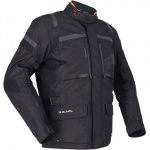In a world where the buzzword for biking is ‘laminate’ I’m going to make the case for something that’s been around a bit longer.
I wore this Richa jacket for a couple of months in a range of conditions, including a 1400-mile tour of northern England and Scotland, and found it to be an excellent performer, despite lacking a laminated outer.
The waterproof membrane in the Richa Brutus Gore-Tex jacket is removable and can be worn as a separate jacket if you wish.
That gives it a few advantages over a laminated jacket (if you’re new to the term, it means the waterproof membrane and outer shell are laminated together to make a two-layer outer).
Firstly, a removable liner is handy on a tour as it saves you putting a lightweight rain jacket in your luggage for off-bike use.
The Brutus’ liner can also be worn over the top of the main jacket, so it stops that getting wet, making it at least as rain-resistant as a laminated jacket.
And then, if the temperature rises, you whip out the waterproof lining completely and have a jacket that will let you stay far cooler. That’s something you can’t do with a laminated jacket.
I found this set-up to be brilliant in my time with the Richa Brutus jacket. On cold days I ran with the waterproof liner in place as well as the separate thermal liner that can also be removed.
I found this kept me warm in conditions down to around 10 degrees Celsius, though when the temperature dropped below that a warm layer underneath would make life more comfortable.
Once it warmed up to around 16 or 17 degrees then I could take out the thermal liner and run with just the waterproof liner in place.
And on the occasions that temperatures got up into the 20s then taking out the waterproof liner and opening up the various vents on the jacket made life much more enjoyable and relaxing.
Photography: Helen Meeds
The two vents at the chest are easy to operate and I found them effective too.
I never faced the sort of sustained rain to warrant wearing the waterproof liner over the top of the main jacket to act as a first line of defence. Having it on the inside was enough for me, and in this state the Richa Brutus repelled an hour or more of persistent rain on the approach to the Isle of Skye.
I found the fit to be excellent for me in size medium, which Richa list as a 40in chest - exactly as I would expect to wear. There’s fit adjustment above and below each elbow, at the waist and at the bottom hem, which helped tailor the fit to suit the layers I wore underneath.
The jacket is easy to fasten, though I found the number of press studs on the inner Gore-Tex jacket stretched my patience a bit. I can see why they’re necessary, to stop rain hitting the zip, but it still frustrated me.
I found the collar to be a comfortable height, though unless it was very cold I preferred to keep it open with an elastic loop that connects to a hook on the collar.
Richa jackets are often narrow at the cuffs, which can make it difficult to fit gloves underneath to get the best rain protection. It was a bit of a fiddle with the Brutus, but I could manage it without too much drama.
Pocket provision is good, with two external pockets at the waist that have fold-over Velcro closures. They’re listed as water-resistant, but have waterproof lining material so the risk is from rain coming in through the top. I had no issues with the contents getting wet, but this might be an issue in prolonged heavy rain.
There’s the ‘map’ pocket at the lower back and that’s big enough to hold the waterproof liner so it’s easily to hand if you need it in a hurry.
Two handwarmer pockets sit behind the external pockets at the waist, which I always find useful, plus three pockets in the main shell and two in the thermal liner. I mainly used the Napoleon pocket at the chest, which was big enough for a phone. My wallet sat in one of the deeper pockets, there in case my phone’s Google Pay ever let me down.
There are two connection zips to attach to trousers. I wore a pair of simple Richa Softshell trousers with this jacket and that meant using the short zip to connect, which was very easy to do.
Armour comes from D3O inserts at shoulders and elbows, which meet the basic Level 1 of the CE standard. Back protection is an optional extra and there are two choices… a full protector for £42.99 at the time of writing, or a slimmer central back protector that’s £52.99. Chest protection can also be inserted into pockets and that’s a £34.99 upgrade at the time of this review.
Protection overall is rated at Level A, which is the most basic within the CE safety standard.
Overall, I found the Richa Brutus Gore-Tex to be a very effective performer. It kept me dry, warm, cool and comfortable at all times.
The lack of a back protector is a bit disappointing for something with a pricetag over £500, as is the fact it only passes CE at the lowest level. I think some riders will also find the cuffs don’t leave enough room to get thick gloves inside.
If you intend to ride in rain a lot then I think a laminated jacket will be more convenient than the Brutus (no need to faff with swapping liners in or out on a laminated jacket). But if you want something that’s better suited to a little bit of every type of climate then I think this offers flexibility that’s hard to beat.












